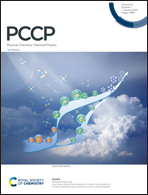Defective graphene/SiGe heterostructures as anodes of Li-ion batteries: a first-principles calculation study†
Abstract
Two-dimensional silicon-based material siligene (SiGe) has a low diffusion barrier and high theoretical specific capacity, but the conductivity drops sharply after being fully lithiated. To improve their electrical conductivity, the three heterostructures (SV-G/S, DV-G/S, and SW-G/S) formed with defective graphene and SiGe were proposed and the feasibility of them as anode materials was analyzed systematically. Based on density functional theory, the structural properties of defective graphene/SiGe heterostructures (Def-G/S), the adsorption and diffusion behaviours of Li, the voltage and theoretical capacity, and electrical conductivity during the lithiation process were investigated. The results show that defective graphene can form a stable heterostructure with SiGe and the heterostructure with defects can accommodate more Li atoms. The good adsorption and low diffusion energy barrier ensure the capacity, cycling, and safety performance of Def-G/S as anode materials. Moreover, Def-G/S significantly improves the conductivity of pristine 2D SiGe after full lithiation. These excellent properties indicate that Def-G/S has great potential as an anode material for Li-ion batteries.



 Please wait while we load your content...
Please wait while we load your content...